Spider-view: "Prepare Yourself for…Annex"
Everything about this annual is mediocre, save one engaging back-up strip honoring the history of a classic character
—by Nathan on June 21, 2025—

Okay, folks, we've reached that time again where we dive into those special, annually produced issues collectively known as…uh, yeah, annuals. These longer-than-normal issues have been a bit contentious for me as of late, with me generally debating whether the main stories they present are better or worse than the included back-up strips. What's more entertaining, a Spidey, Iron Man, and Black Panther team up or a Fred Hembeck-illustrated gag strip? How about we debate the merits of Spidey leading the New Warriors against the Sphinx vs. Cloak and Dagger battling Lightmaster? Aspects of these annuals can be entertaining, but they rarely arrive at my expectations. The real argument is whether I wish we were back in the days where Spidey annuals represented three chapters of an overarching fourteen-part saga stretching across the Marvel Universe.
I get the appeal of annuals: you're allowed to tell stories that wouldn't be produced in regular narratives. Yeah, Spidey's got four ongoing titles, but they usually have writer/artist teams churning out somewhat longer stories. Unless you find space for a fill-in narrative, you can't just plop a random story into production. These annuals allow for that more unique experience, plus opportunities to allow other voices in Spidey's world to get a little say.
So we're back with an Amazing Spider-Man annual, published the same month Harry Osborn "died." Spidey's next crossover epic, "Maximum Carnage," began the same month as this annual was produced as well, and though I'll be covering that story in the next "Spider-view" post, don't expect any build-up here. No Venom, no Carnage, no symbiotes of any kind. But that doesn't mean we can escape the egregious "90s-ness" of comics either.
"Prepare Yourself for…Annex"
Writers: Jack C. Harris, Eric Fein, and Mike Lackey
Pencilers: Tom Lyle, Scott Kolins, Aaron Lopresti, and Larry Alexander
Inkers: Scott Hanna, Bud LaRosa, and Andy Mushynsky
Colorists: Bob Sharen, John Kalisz, Renee Witterstaetter, and Rob Tokar
Letterers: David Sharpe, Richard Starkings, and Joe Rosen
Issue: Amazing Spider-Man Annual #27
Publication Date: May 1993
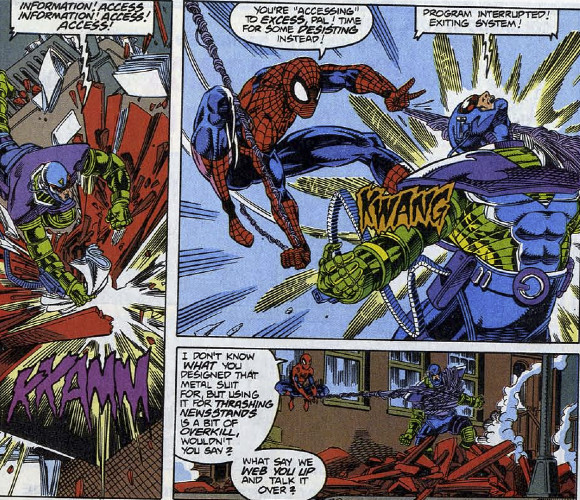
Of the annual issues I've discussed in recent memory, this may mark the low point in my experience. Even when Spidey annuals were middling at best, something would jump out at me at being worthwhile to review–that genuinely amusing Fred Hembeck strip or a strong backup Mary Jane tale in the style of 12 Angry Men. Additionally, stories told across three annuals–Amazing, Spectacular, and Web of Spider-Man–have had some meat to them, a trio of chapters for creators to tell longer, slightly more developed narratives.
For this first 1993 annual, we don't get that. Oh, the setup for this individual ASM annual is the same: a somewhat longer main tale followed by a small assortment of shorter narratives. But there's less substance found here across the whole issue…which I guess seems fair for an issue where the main story is about a guy who can create weapons and armor from basically thin air.
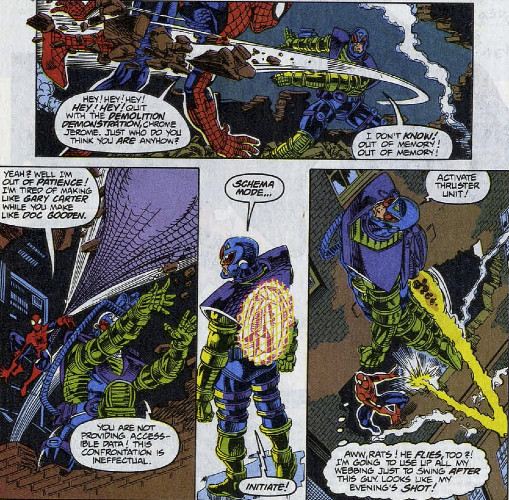
You recognize that writer Jack C. Harris has a story he wants to tell, and you can see that he has a concept sketched out from basically start to finish. "Prepare Yourself for…Annex" is a coherent narrative, with a definitive start and end point. There's a villain, conflict, a central mystery…all the elements needed for a good story to be told.
It may sound that I'm talking a bit disparaging about the man, and I don't mean to be. I'm not mockingly acknowledging that Harris knows at least the basics of competent storytelling. But though "Annex" is competently told, it's just a story which did not resonate with me. The tale focuses on Spidey engaging a former soldier in experimental armor who can create weaponry and armor through a mental link with bio-regenerative living matter. He needs a gun? Boom, he's got a gun. He needs a prosthetic leg? Whammo, there's a prosthetic leg, conjured from his mind and attached to his body through the armor. But when systems go awry, Annex finds himself in conflict with Spidey as our hero tries sorting the whole mess out.
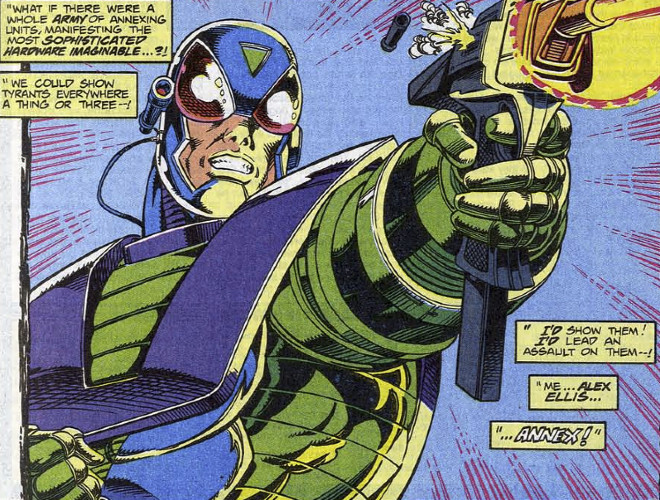
The biggest issue, as I see it, is Harris attempting to cram several high-end ideas into this narrative. We're given a good deal of exposition explaining just what the heck is going on, and though it amply explains just what the deal with Annex is, there are too many concepts at one time for such a story. We're talking a tale with a very limited focus and using it to not only introduce a new super-soldier but also new technology, a new company, and new supporting cast members, which feels like a lot for the reader to absorb across twenty-five pages. Then you gotta have your action sequences, cause Spidey's gotta fight somebody and rescue somebody else…all the material is there, it just feels rushed.
To his credit, Harris weaves in a capably executed plot twist that I will admit to not seeing coming. He uses misdirection in a way that I feel is deliberate, swerving at the last second to avoid what I would have critiqued as an extremely obvious plot twist for something a bit more engaging. The twist does allow Annex more of a personality and gives him greater stake in the ongoing conflict, with Harris then actually incorporating what I thought was the obvious twist later in the story as the bedrock for our villain's scheme. It's a clever switcheroo that impressed me yet remained really the only aspect of the story I found unique. Otherwise, Annex is a dude in metal armor with big guns…something the 90s definitely didn't need more of by any stretch of the bio-regenerative imagination. When Spidey ends the issue by saying "we haven't heard the last from Annex," I chuckled, thinking there was no way this character was ever used again…and then the internet laughed back, because according to his Marvel Database page, he's made twenty-two other appearances since this annual, including his own four-issue limited series!
Well played, Annex. Well played.
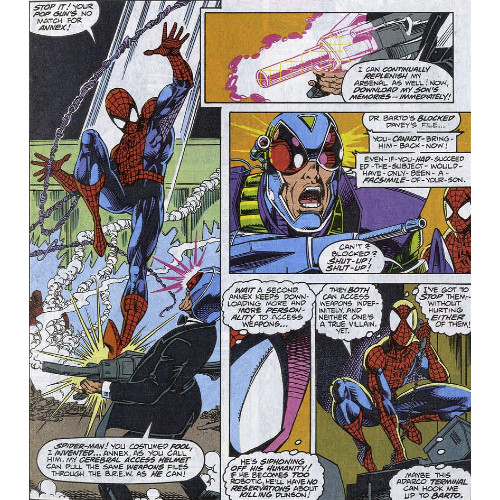
The back-up narratives are about as middling as the main tale. We're given three narratives–one focused on a Black Cat and Solo "team-up," one centered on Curt Connors (sans scaly alter ego), and one spotlighting John Jameson. Both the Black Cat/Solo and Jameson stories feel like tired attempts at giving two supporting cast members more "oomph" outside the parameters of the regular-length Spidey series. Writer Eric Fein attempts to develop the younger Jameson into an armored vigilante in light of actions from a previous appearance. This "turn John Jameson into a superhero" angle has been attempted before, perhaps most famously by Stan Lee and John Romita, and it's never stuck. The longest John has retained an alter ego was the Man-Wolf, which, despite John seemingly being cured, has flared up time and again. It's like a curse the poor guy can't escape.
The most engaging back-up strip centers on Connors, writer Mike Lackey giving a pretty decent overview of the Lizard's history in a courtroom drama sequence, Connors having been arrested after the Lizard murdered several people under Calypso's control. A debate rages over whether Connors himself is a menace to society or if he can control his reptilian half, and the arguments provided, structured around the Lizard's multiple appearances, make for an interesting tale. With a host of supporting characters popping in–including Curt's wife and kids, Peter Parker, and that Web-Head who appears whenever Peter vanishes–and reminders of alliances and fights with Stegron the Dinosaur Man and Morbius, the story is a good reminder of the Lizard's staying power as a villain and the duality he represents. It's the best of the tales we're given.
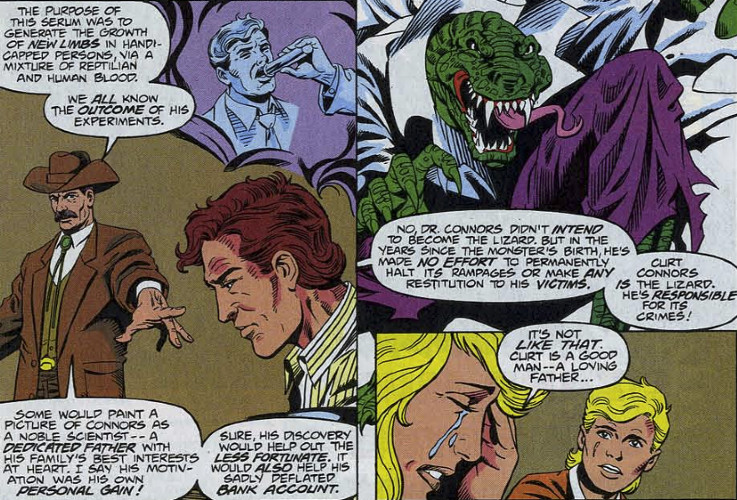
Go ahead and turn on your faucet for me. Jiggle the handles between "cold" and "hot" until you get a temperature between the two and take a sip. It's lukewarm, isn't it? And, yet, though it's neither too hot nor too cold, it isn't quite that perfect bowl of porridge Goldilocks stumbled across. Lukewarm water is just that…lukewarm. Meh. And that's the prevailing feeling across this annual. Our writers do try things with their stories–the main tale tries to create a new, modern villain/vigilante, the back-up strips attempt to deliver engaging takes on established characters. Only Lackey's strip prevails in that regard, in my mind. His take on the Lizard gets in-between the scales and allows good reflection on why the villain is a mainstay. And maybe that's why the other tales don't hold up as well: they try to coat fresh paint on older characters, forgetting we don't mind the chips in the figures we've read about for decades.